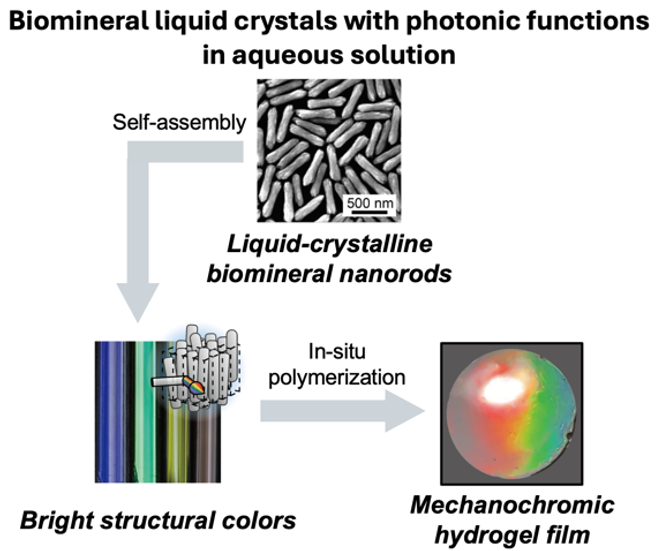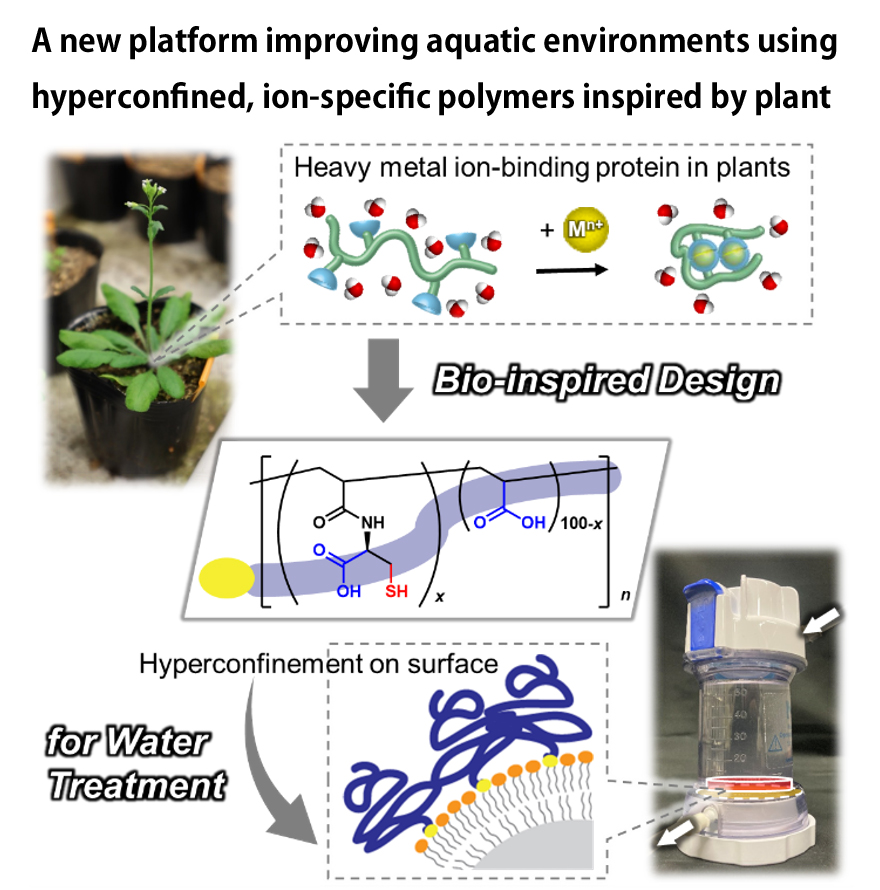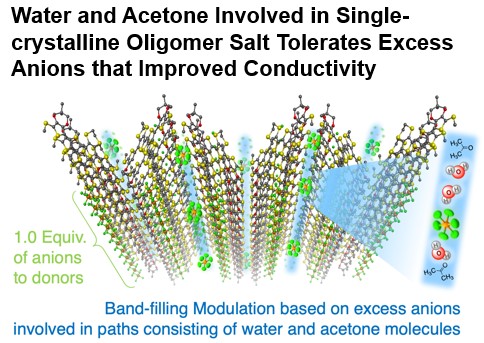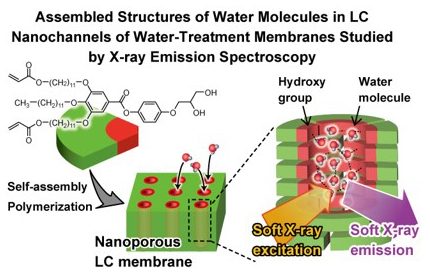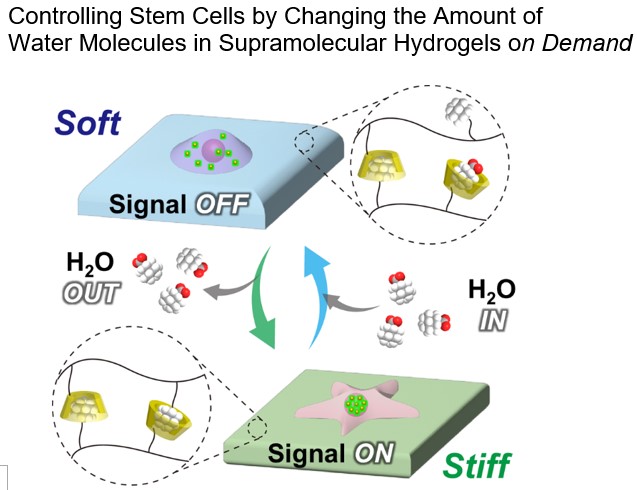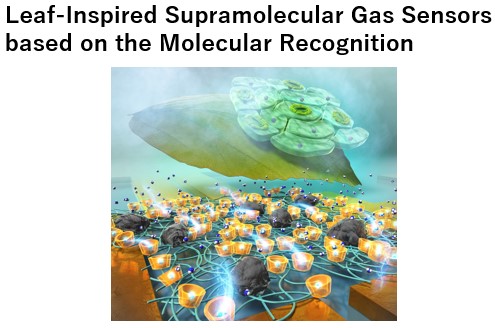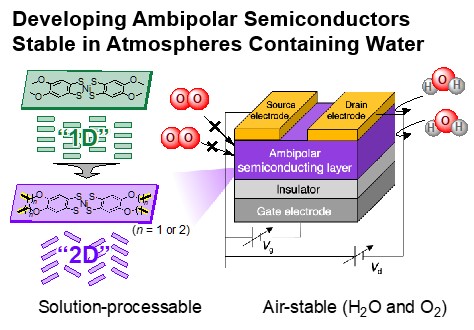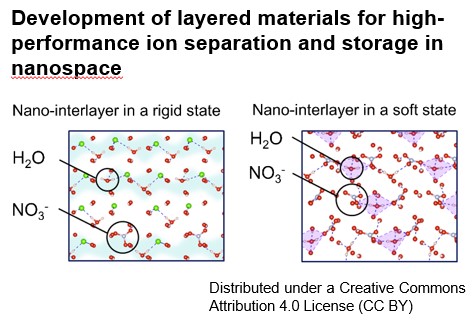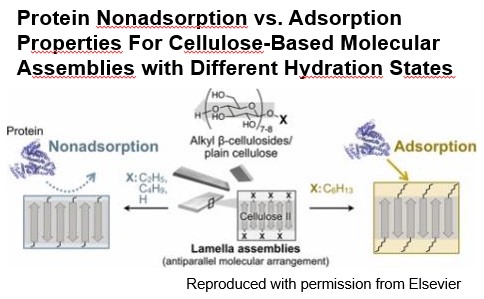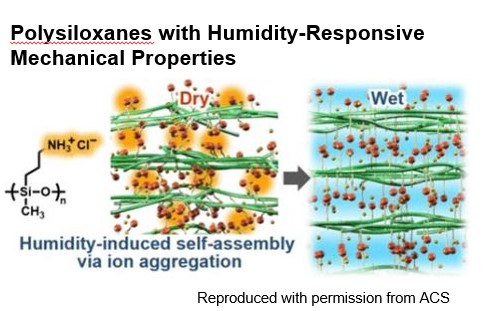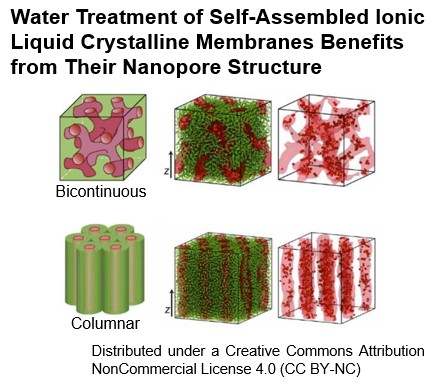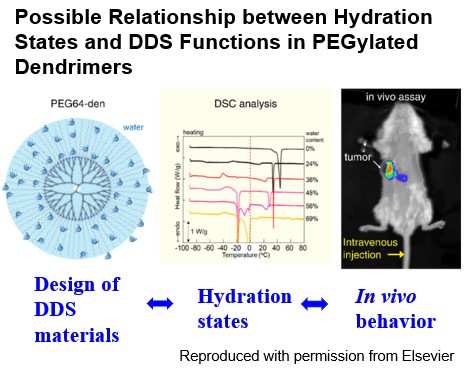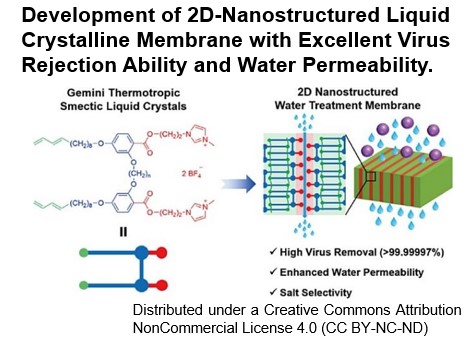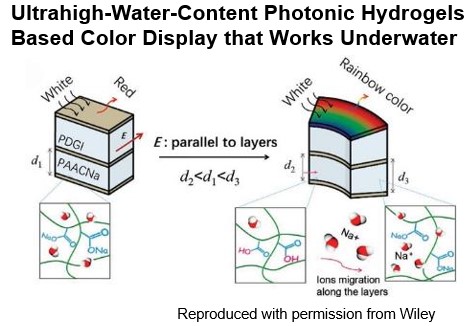Recent News
-
July 12, 2024
Prof. Takashi Kato (Project Leader, A01 Principal Investigator of Research Group A01-1, The University of Tokyo) and his colleague reported photonic materials exhibiting vivid structural colors formed from biomineral liquid crystals in an Early View in the German international scientific journal "Advanced Materials" on June 26, 2024. The research released in the University of Tokyo (websites of the Head Office and the Dept. of Engineering) on July 12, 2024.
Advanced Materials, Website of the Head Office, Website of the Dept of Engineering -
July 10, 2024
Research on "polysaccharide interface division," which has been studied for many years by Associate Prof. Kosuke Okeyoshi (A03 Principal Investigator of Publicly Offered Research, Japan Advanced Institute of Science and Technology), was introduced in the section of "Challenging - From the Science Field." of the electronic edition of YOMIURI News Paper. Click here
-
March 31, 2024
The research period for the scientific research grant for aquatic functional materials has ended as of today. Thank you very much for your cooperation and support. We will continue to do our best to further develop this field, so we look forward to your continued support.
-
26 Feb. 2024
The 18th Newsletter (Aquatic Functional Materials News) is now available online. The 7th Area Meeting is reported. Click Here
-
22 Jan. 2024
The 17th Newsletter (Aquatic Functional Materials News) is now available online. The meeting of the evaluation committee of the International Advisory Board is reported. Click Here
-
8 Nov. 2023
The 16th Newsletter (Aquatic Functional Materials News) is now available online. This Newsletter report the 2nd and 3rd Industry Internships, the public project held within the 13th CSJ Festa. Click Here
-
23 Oct. 2023
The 13th CSJ Chemistry Festa2023 (organized by The Chemical Society of Japan) was held from October 17th (Tue) to 19th (Thurs), 2023 at Tower Hall Funabori (Tokyo). We presented a following public seminars of KAKENHI project on “Aquatic Functional Materials: Creation of New Materials Science for Environment-Friendly and Active Functions”. Click Here
-
22 May 2023
AIST issued a press release regarding a study by Masahiko Imashimizu (Principal Investigator of Publicly Offered Research A02, AIST) and Mafumi Hishida (Co-Investigator of Research group A02-1, Tokyo University of Science) on nonthermal acceleration of protein hydration by sub-THz irradiation. Combining the highly sensitive microwave dielectric relaxation measurement with THz spectroscopic measurement, they captured changes in the hydration structure during and after sub-THz irradiation. The research was published in Nature Communications (featured in Editors’ Highlights).
-
21 May 2023
On May 21, 2023, a humidity-responsive silicone developed by Mitsuo Hara (A01 Publicly Offered Research Group, Nagoya University) was featured on Nippon Television Network Corporation “Tokoro-san no Me ga Ten!” under the theme “A Mysterious Material Close to Us! What is Silicone?” The broadcast content can be viewed for one week on the streaming service TVer, and for one year on Hulu.
-
12 Apr. 2023
The 15th Newsletter (Aquatic Functional Materials News) is now available online. The 6th Area Meeting, the 3rd Industry-Academia Collaboration Forum, the 2nd Academia Internship, and the 3rd Young Scientists School are reported. Click Here
-
5 Oct. 2022
The 14th Newsletter (Aquatic Functional Materials News) is now available online. Click Here
-
8 Aug. 2022
The 13th Newsletter (Aquatic Functional Materials News) is now available online. Click Here
-
1 Aug. 2022
The 12th Newsletter (Aquatic Functional Materials News) is now available online. Click Here
-
11 Jul. 2022
The 11st Newsletter (Aquatic Functional Materials News) is now available online. Click Here
-
9 May 2022
The 5th Research Area Meeting of Aquatic Functional Materials (not open to the public) was held online from May 9th (Mon) to 10th (Tus), 2022. From Apr 2022, the second half of the 4th and 5th fiscal year has started. Researchers of Publicly Offered Research have joined the research area. The 5th Research Area Meeting confirmed collaborative activities within the area to further develop and deepen the research in the area.
-
6 May 2022
The 10th Newsletter (Aquatic Functional Materials News) is now available online. Click Here
The Newsletter introduces the 4th Research Area Meeting of Aquatic Functional Materials and the 2nd Industry-Academia Collaboration Forum. -
20 Apr. 2022
On April 20, 2022, Go Watanabe (Co-Investigator of Research Group A02, Kitasato University) and Takashi Nakamura (Investigator of Research Group A01/Publicly Offered Research, Tsukuba University) received The Young Scientists’ Award, the Commendation for Science and Technology by the Minister of Education, Culture, Sports, Science and Technology (commendation organization: Ministry of Education, Culture, Sports, Science and Technology (MEXT), Japan). The Young Scientists’ Award is awarded to researchers under the age of 40 who have made outstanding achievements in research, originality, and outstanding research & development (R&D) capabilities. The official press release from the MEXT is readable here.
-
1 Apr. 2022
With new Publicly Offered Researchers on this “Aquatic Functional Materials” project, we are going to kick off a fresh start on the research activities to further deepen the science about “Aquatic Functional Materials”. They were selected based on the proposals for Publicly Offered Research (FY2022-FY2023) in the Grant-in-Aid for Scientific Research.
-
4 Feb. 2022
The 2nd Industry-Academia Collaboration Forum (open to the public) was held online.
More than 500 participants, mainly from industry, joined the forum, the researchers from Planned Research and Publicly Offered Research gave lectures, and we had active discussions. The participants from industry showed the expectations for new perspectives on water in this project toward sustainable society where materials are in harmony with environment. -
25 Jan. 2022
The 4th Research Area Meeting of Aquatic Functional Materials (not open to the public) was held online.
Researchers from Publicly Offered Research gave lectures about the results of their researches obtained over the past two years, as well as their joint research and collaboration activities within the research area. Active discussions on the new science about water were held, and collaborative activities within the area were also discussed. -
17 Jan. 2022
Kyushu University issued a press release concerning "Functionalization mechanism of blood-compatible polymer" examined by Masaru Tanaka (Principal Investigator of Research group A03-2, Kyushu University) and Yoshihisa Harada (Principal Investigator of Research group A02-1, The University of Tokyo). The article is here. Synthesis and interfacial analyses by Tanaka group were combined with soft x-ray emission spectroscopy by Harada group to reveal the hydration mechanism of the blood-compatible polymer. The research was published in the international journal Langmuir, and selected as a Supplementary Cover of the issue.
-
29 Dec. 2021
The 9th Newsletter (Aquatic Functional Materials News) is now available online. Click Here
-
18 November 2021
The article entitled "Bioinspired design of functional liquid crystals working with water" to promote the research content has been published in Chemistry Today (December issue) from Tokyo Kagaku Dojin publishing. (page 20-21)
-
18 Nov. 2021
On October 27, 2021, a research paper entitled “Uniaxially Oriented Electrically Conductive Metal–Organic Framework Nanosheets Assembled at Air/Liquid Interfaces” reported by Rie Makiura (Co-Investigator of Research group A01, Osaka Prefecture University) was published online and selected as a Supplementary Cover.
The research achievement was press-released by Osaka Prefecture University, The University of Tokyo, and SPring-8/JASRI and highlighted by EurekAlert!, AsiaResearchNews and AZONANO. -
28 October 2021
The academic and research activities which have been carried out for many years by Takashi Kato (Project Leader, Principal Investigator of Research group A01, The University of Tokyo) were introduced in a national edition of Asahi Shimbun (28 October 2021, morning edition, education section), under the title of " Lesson to tomorrow -The interesting of liquid cystals, Talked at school visiting lecture-". The article can be read online (newspaper site).
-
27 October 2021
Maki Kawai (Evaluation Committee, Director General, Institute for Molecular Science, National Institute of Natural Sciences) was awarded as Person of Cultural Merit of Year 2021.
Person of Cultural Merit is awarded by Ministry of Education, Culture, Sports, Science and Technology to selected people who have made outstanding contributions to the advancement and developement of Japanese culture. Congratulations. -
18 October 2021
The article entitled "Synthesis of novel high performance organic materials interact with environment in the existance of water" to promote the research content has been published in Chemistry Today (November issue) from Tokyo Kagaku Dojin publishing. (page 32-33)
-
1 October 2021
The article entitled "Development of new functions of supramolecular materials by controlling interfacial water molecules" to promote the research content has been published in Chemistry Today (September issue) from Tokyo Kagaku Dojin publishing. (page 26-27)
Takashi Kato (A01) and co-workers have successfully synthesized biomineral-based aquatic colloidal liquid crystals composed of fluoroapatite/polymer hybrids. They exhibited photonic functions displaying bright structural colors. The liquid crystals immobilized in polymer networks showed mechanochromic properties.
Advanced Materials, 2404396, Early View, (2024).
Press Release: Head Office of UTokyo, Dept of Engineering of UTokyo
News and Highlights: Nikkei, Mynabi news, BIGLOBE news, OPTLONICS, JST (Chinese)
Motomu Tanaka (A03), Masaki Nakahata (A03), Yuka Ikemoto (A02) and Takashi Nakamura (A01) have developed polymeric materials inspired by plant proteins that selectively capture and neutralize heavy metal ions such as cadmium. Through international collaboration with Heidelberg University (Germany), they succeeded in the hyperconfinement of the bio-inspired polymer and dramatically improved the selective ion trapping capacity. They demonstrated that this system enables to improve the aquatic environment by removing harmful heavy metal ions in simulated industry wastewater down to the drinkable level.
Nat. Commun., 15, 5824-1/10 (2024).
Online release: Jul. 11, 2024
Press release: Osaka University, Kyoto University
Nihon Keizai Shimbun, Springer Nature Research Communities, EurekAlert!, Asia Research News, ScienMag, Phys.org, Nanowerk, Bioengineer.org, Smart Water Magazine, AZoMaterials, Chem Europe, Mirage News, Technology Networks,
Water Online, Innovazione.
Tomoko Fujino (A01) and her colleague have developed single-crystalline oligomers models of doped polyethylenedioxythiophene (PEDOT). This study achieved a room temperature conductivity 1,000,000 times higher than that of the dimer salt in a charge transfer salt of a tetramer with a mixed sequence, realizing a metallic state at room temperature and above. The key to high conductivity was the pathway created by the water and acetone included in the single crystal. The excess anions incorporated into this pathway caused the band filling rate to deviate from the half-filled state.
J. Am. Chem. Soc. 2023, 145 (28), 15152–15161.
Press release: The Univ. of Tokyo, JST, IMS
Takashi Kato (A01) and Motomu Tanaka (A03) have fabricated a new composite electronic material by functionalizing the surface of GaN semiconductor with a supramolecular liquid-crystal membrane possessing a unique anion selectivity under international collaboration with University of Bremen (Germany). By analyzing the electric signals obtained by chronoamperometry, they unraveled the mechanism of selective transport of large, divalent sulfate ions through the nano-porous membrane compared to small, monovalent chloride ions.
J. Phys. Chem. B, 2024, 128, 4537−4543.
DOI: 10.1021/acs.jpcb.4c00047
Supplementary Cover
On line release: April 29, 2024.
Takashi Kato (A01), Yoshihisa Harada (A02) and coworkers have examined hydrogen-boned structures of water molecules in the hydroxy-group-functionalized one-dimensional nanochannels (diameter: ca 1.5 nm) of liquid-crystalline (LC) nanostructured membranes with soft X-ray emission spectroscopy. Unlike the case of the ionic LC nanochannels (Ref: Kato and Harada, Angew. Chem. Int. Ed., 59, 23461-23465 (2020)), the water molecules confined in the LC nanochannels covered with hydroxy groups exhibit hydrogen-bonded structures close to those of bulk liquid water. These findings provide new insight of the separation mechanisms and new approaches to novel function designs of LC membranes.
J. Phys. Chem. Lett., 15, 454-460 (2024).
Motomu Tanaka (A03), Yoshinori Takashima (A03) and Masaki Nakahata (A03) have developed the hydrogel membranes whose stiffness can be switched on demand by changing the degree of hydration. Under international collaboration with Heidelberg University Hospital (Germany), they found that human stem cells feel the substrate elasticity beyond a certain threshold. Moreover, stem cells change their biological function when the stiffness was switched too frequently.
Adv. Healthcare Mater. 13, 2302607 (2024).
Back Cover
Online release: Dec. 20, 2023
Hayato Tsuji(A01), Masaki Nakahata (A03), Mafumi Hishida (A02), Hideki Seto (A02) and coworkers have observed aggregation behavior of hydrophobic fluorescent molecule in water-tetrahydrofuran (THF) mixed solvent. They have observed that water and THF molecules form varieties of micro-mesoscopic scale structures, where hydrophobic molecules are distributed to form aggregation. They have also elucidated that the aggregation state of the solute and the size of the aggregate accordingly change upon changing the mixing ratio of water and THF, which significantly affects the fluorescence properties of the solution.
J. Phys. Chem. Lett., 14, 11235-11241 (2023).
Supplementary cover
Press Release: Kanagawa University, Osaka University, Tokyo University of Science, KEK, J-PARC、JAEA
Yoshinori Takashima (A03), Yuta Nishina (A01), Go Matsuba (A03), Yuka Ikemoto (A02) , and coworkers fabricated the stress-strain sensors using the composites between stretchable polymers and carbon-filler. The composites detected applied stress-strain through resistance changes.
ACS Polymers Au, 3, 394-405 (2023).
Front Cover
Yoshinori Takashima (A03), Hitoshi Washizu (A02), Tsuyoshi Minami (A01), and co-workers prepared gas sensors based on supramolecular polymers with reversible crosslinks and carbon materials. The gas sensors selectively detected ammonia compounds through the molecular recognition of cyclodextrins.
ACS Appl. Mater. Interfaces, 15, 39777-39785 (2023).
Masahiko Imashimizu (A02), Mafumi Hishida (A02) and co-workers have successfully observed that externally applied sub-THz electromagnetic fields perturb the rapid collective dynamics in protein-water systems. They further verified the relevance of this observation with THz and NMR spectroscopies. They found that a protein hydration change, which usually takes a long time, is significantly accelerated by the sub-THz irradiation.
Nat. Commun., 14, 2825 (2023),
Editors’ Highlights.
Press Release: AIST, Tokyo University of Science
Tomoko Fujino (A01), Rie Makiura (A01) and coworkers developed single-component, ambipolar semiconductors, stable even in air containing water and oxygen. These materials are solution-processible and highly crystalline, even in thin film forms, exhibiting excellent ambipolar charge-transport properties with high carrier mobility of up to 10–2 cm2V–1s–1 and large on/off ratios of up to 105. They are inert to water and oxygen and stable even after several months of exposure to air.
J. Am. Chem. Soc., 145, 2127-2134 (2023),
Supplementary Cover
Press Release: ISSP, The University of Tokyo News and Highlights: Nikkan Kogyo Shimbun
Katsuya Teshima (A02) and co-workers synthesized layered double hydroxides with high crystallinity, cation state, porosity, and unique particle shape. They demonstrated that a 24% reduction in the packing density of interlayer ions effectively promotes a two-dimensional hydrogen-bonded structure in water around nitrate ions, increasing the storage capacity of nitrate ions by 300%, while minimizing changes in the layered structure.
Nat. Commun., 13, 6448-1/9 (2022).
Press Release: Shinshi University
Takeshi Serizawa (A01), Go Watanabe (A02), Masaru Tanaka (A03) and co-workers systematically revealed the relationship between hydration states and protein nonadsorption/adsorption properties for cellulose-based molecular assemblies.
Colloids Surf. B: Biointerfaces, 220, 112898-1/9 (2022).
Yuka Ikemoto (A02), Hajime Torii (A02), Yoshihisa Harada (A02), Masaru Tanaka (A03), Hitoshi Washizu (A02) and coworkers showed that the OH stretching frequency of water is controlled by the electric field perceived by the H atoms and is well correlated with the water arrangement at the polymer interface by theoretical calculations compared with infrared absorption spectra of different biocompatible polymers under humidification.
J. Phys. Chem. B., 126, 4143-4145 (2022).
Mitsuo Hara (A01), Yoshihisa Fujii (A03) and co-workers synthesized water-soluble polysiloxanes containing alkylamine hydrochloride side chains. The resulting polysiloxanes exhibit changes in mechanical properties due to intra- and inter-molecular ionic aggregation and high ordering of the main chain structure induced by humidity.
Macromolecules, 55, 4313-4319 (2022).
Masaru Tanaka (A03), Yoshihisa Harada (A02), Yuka Ikemoto (A02) and coworkers showed by atomic force microscopy, quartz crystal microbalance, and soft X-ray emission spectroscopy that water on polymers causes phase separation and water in tetrahedral coordination coexisting with water adsorbed on C=O groups in low-density regions provides a scaffold for intermediate water formation, contributing to blood compatibility.
Langmuir, 38, 1090-1098 (2022).
Cover Picture
Yoshifumi Hashikawa (A01) and co-workers observed quantum rotational excitations of a water molecule using H2O@C60 single-molecule transistors and revealed that an ortho-para conversion of the encapsulated water molecule occurs within a minute, probably due to interaction between the valence electrons of H2O molecule and the conduction electrons of 60.
Nano Lett., 21, 10346-10353 (2021).
Press release: Kyoto Univ., UTokyo, Tohoku Univ.
News and Highlights: Nikkei Shimbun, Nikkan Kogyo Shimbun, EurekAlert!
Rie Makiura (A01) and co-workers successfully fabricated uniaxially oriented MOF nanosheets that show high electric conductivity using a simple method of dropping a solution onto the surface of water.
ACS Appl. Mater. Interfaces, 13, 54570-54578 (2021).
Press release: Osaka Pref. Univ.
News and Highlights: Nikkei Shimbun, Nikkan Kogyo Shimbn,
Mynavi news, EurekAlert!, AsiaResearchNews、AZONANO, ScienceDaily, Phys.org、Mirage.News, Nanowerk
Koji Harano (A01), Motomu Tanaka (A03) and their co-workers synthesized a 3-nm-thick nanofilm with large-area uniformity over tens of cm2, which is composed of a fullerene double layer holding a water layer between them. The film can be transferred onto a variety of substrates including gold comb electrodes, and shows high proton conductivity through hydrogen-bonded network of the water layer inside.
Adv. Mater., 34, 2106465-1/10 (2022).
Hitoshi Washizu (A02), Takashi Kato (A01), Go Watanabe (A02) and co-workers performed large-scale molecular dynamics simulations of self-assembled ionic liquid crystalline membranes and reproduced the nanochannel structure obtained by X-ray diffraction. Hydrogen-bond analysis of water showed that the one-dimensional ionic nanochannel structure is suited for dissolution and diffusion of water in the nanochannel.
Sci. Adv., 7, eabf0669-1/14 (2021).
Online Cover
Press Release: Univ. of Hyogo, Hyogo Prefectural Board of Education, Osaka Univ., Kitasato Univ., Dept. Eng., UTokyo
News and Highlights: Nikkei Shimbun
Chie Kojima (A03) synthesized PEGylated dendrimers with high and low PEG density as a model of drug carrier, and investigated their hydration states and biodistribution, collaborating with Shigeaki Morita (A02) and Masaru Tanaka (A03). They suggested a relationship between the hydration states and the tumor accumulation (blood circulation) property.
Mater. Sci. Eng. C, 126, 112159-1/7 (2021).
Takashi Kato (A01), Jiro Kumaki (A02) and their coworkers have developed a 2D thermotropic smectic liquid-crystalline (LC) membrane with gemini-type nanostructure composed of cationic imidazolium moieties showing over 99.99997% virus rejection ability and improved water permeation.
ACS Appl. Mater. Interfaces, 13, 20598-20605 (2021).
Youfeng Yue (A03) and co-workers fabricated ultra-high water content 1D photonic hydrogels exhibiting a large electro-optical response in the entire wavelength range from visible to near-infrared region due to ionic diffusion, which maintain electrically printed patterns underwater for a long time. These full-color properties are expected to pave the way for next-generation reflective displays for underwater applications.
Adv. Opt. Mater., 9, 2002198-1/9 (2021).
Collaboration by Takashi Kato (A01) and Yoshihisa Harada (A02) has revealed that water treatment membranes based on liquid crystalline polymers recognize the hydrogen-bonded structure of water surrounding ions to allow selective ion permeation.
Angew. Chem. Int. Ed., 59, 23461-23465 (2020).
Press release: Dept. Eng., UTokyo, ISSP, UTokyo
News and Highlights: Nikkei, Nature Reviews Chemistry (Research Highlight)
Youhei Takeda (A01) and co-workers developed porous molecular crystals that show reversible color change in response to humidity. In collaboration with Yuka Ikemoto (A02) they revealed that the color change is due to changes in the molecular structure and nature of the pores in the crystals depending on humidity.
Commun. Chem., 3, 118-1/8 (2020).
Press release: Osaka Univ., JASRI
News and Highlights: Optronics, ScienceDaily、Phys.org., EurekAlert!
Contact
Takashi Kato LaboratoryDepartment of Chemistry and Biotechnology, School of Engineering, The University of Tokyo, 7-3-1 Hongo, Bunkyo-Ku, Tokyo 113-8656, Japan
Email:office@aquatic-functional-materials.org

